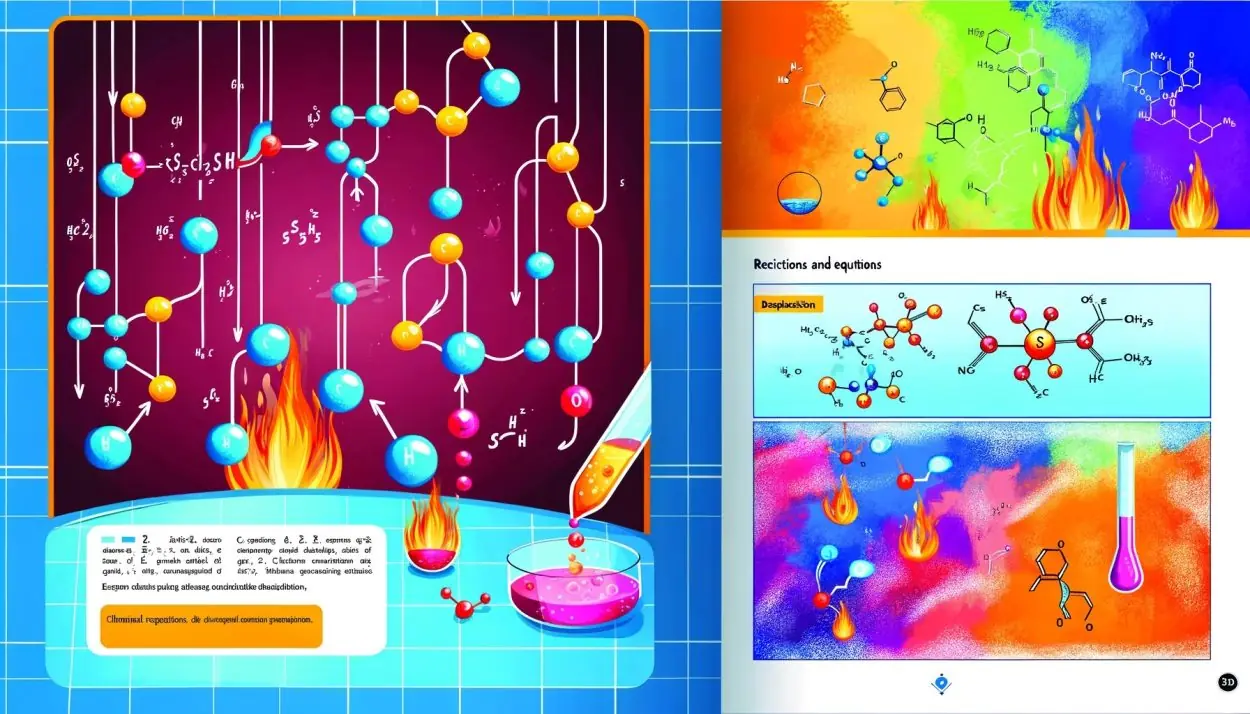
Exploring Types of Chemical Reactions: A Comprehensive Guide for Class 10 Science Students

Class – X th, Subject : Science
Chemical reactions and equations
Q.1 The types of chemical reactions given below are-
(1) Pb + CuCl → PbCl + Cu
(2) 2Mg+O→ 2 MgO
(3) ZnO+C→ Zn+CO
(4) CuO+H, Cu + H₂O
(5) CuSO+Zn → ZnSO + Cu
(6) CuSO + Fe → FeSO4 + Cu
(7) AgNO,+KCI → AgCl + KNO,
(8) CaO + H₂O → Ca(OH) + heat
(9) 2FeSO, FeO + SO + SO,
(10) 2Pb(NO₂), 2PbO+4NO2 + O
(11) Na₂SO₄ + BaSO → BaSO + 2NaCl
(12) 2PbO + C2 Pb+ Pb + CO,
(13) FeO,+2Al→ AlO + 2Fe
(14) MnO2 + 4HCl → MnCl2 + 2H₂O + CI
(15) CaCO, CaO + CO
Types of Chemical Reactions Explained in English:
Here’s an explanation of the types of chemical reactions given in your question:
(1) Pb + CuCl → PbCl + Cu (Single Displacement):
- Lead (Pb) replaces copper (Cu) in copper chloride (CuCl) to form lead chloride (PbCl) and pure copper (Cu).
(2) 2Mg + O → 2MgO (Combination):
- Two magnesium atoms (Mg) combine with one oxygen atom (O) to form two magnesium oxide molecules (MgO).
(3) ZnO + C → Zn + CO (Redox):
- Zinc oxide (ZnO) loses oxygen to carbon (C), forming zinc metal (Zn) and carbon monoxide (CO). This involves oxidation (ZnO loses oxygen) and reduction (C gains oxygen).
(4) CuO + H2 → Cu + H2O (Redox):
- Copper oxide (CuO) loses oxygen to hydrogen gas (H2), forming copper metal (Cu) and water (H2O). Again, oxidation and reduction occur.
(5) CuSO4 + Zn → ZnSO4 + Cu (Single Displacement):
- Zinc (Zn) displaces copper (Cu) in copper sulfate (CuSO4), forming zinc sulfate (ZnSO4) and pure copper (Cu).
(6) CuSO4 + Fe → FeSO4 + Cu (Single Displacement):
- Similar to above, iron (Fe) replaces copper (Cu) in copper sulfate (CuSO4) to form iron sulfate (FeSO4) and copper (Cu).
(7) AgNO3 + KCl → AgCl + KNO3 (Double Displacement):
- Silver nitrate (AgNO3) and potassium chloride (KCl) exchange ions, forming silver chloride (AgCl) and potassium nitrate (KNO3).
(8) CaO + H2O → Ca(OH)2 + heat (Combination):
- Calcium oxide (CaO) reacts with water (H2O) to form calcium hydroxide (Ca(OH)2), releasing heat.
(9) 2FeSO4 → FeO + SO2 + SO3 (Decomposition):
- Iron sulfate (FeSO4) breaks down into iron oxide (FeO), sulfur dioxide (SO2), and sulfur trioxide (SO3).
(10) 2Pb(NO2)2 → 2PbO + 4NO2 + O2 (Decomposition):
- Lead nitrite (Pb(NO2)2) decomposes into lead oxide (PbO), nitrogen dioxide (NO2), and oxygen (O2).
(11) Na2SO4 + BaCl2 → BaSO4 + 2NaCl (Double Displacement):
- Sodium sulfate (Na2SO4) and barium chloride (BaCl2) exchange ions, forming barium sulfate (BaSO4) and sodium chloride (NaCl).
(12) 2PbO + C → Pb + PbO2 + CO2 (Redox):
- Carbon (C) reduces one lead oxide molecule (PbO) to lead metal (Pb), while oxidizing another to lead dioxide (PbO2). Carbon dioxide (CO2) is also formed.
(13) Fe2O3 + 2Al → Al2O3 + 2Fe (Redox):
- Aluminum (Al) reduces iron oxide (Fe2O3) to iron metal (Fe), forming aluminum oxide (Al2O3). Oxidation and reduction occur simultaneously.
(14) MnO2 + 4HCl → MnCl2 + 2H2O + Cl2 (Redox):
- Manganese dioxide (MnO2) loses oxygen to hydrochloric acid (HCl), forming manganese chloride (MnCl2), water (H2O), and chlorine gas (Cl2).
(15) CaCO3 → CaO + CO2 (Decomposition):
- Calcium carbonate (CaCO3) breaks down into calcium oxide (CaO) and carbon dioxide (CO2).